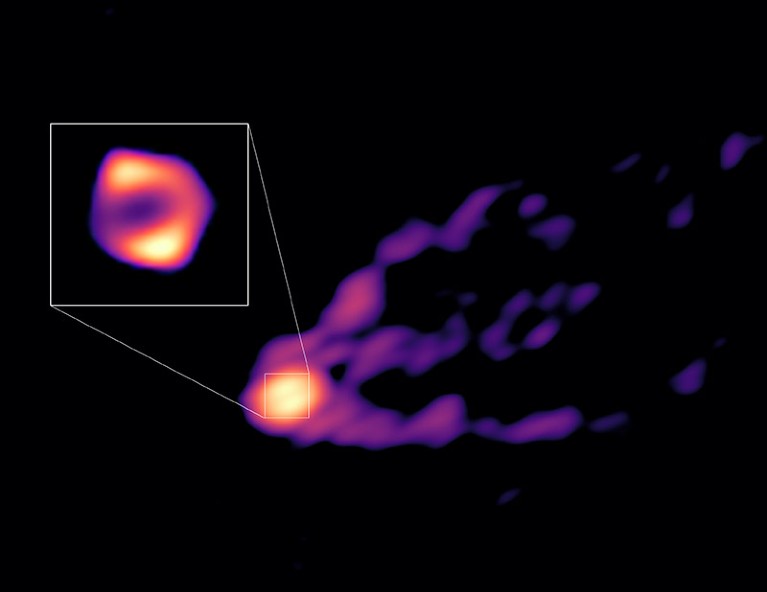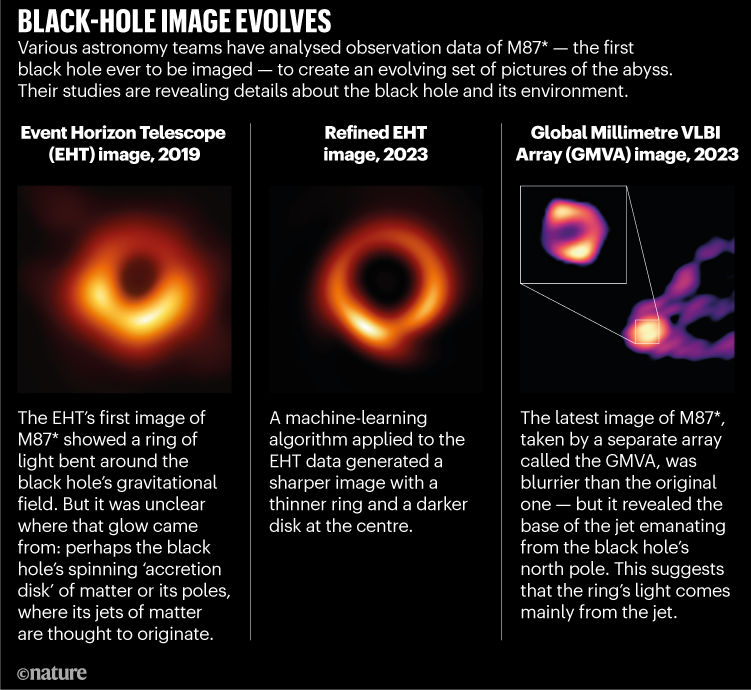Hello Nature readers, would you like to get this Briefing in your inbox free every day? Sign up here.

The latest image of the black hole M87* shows a three-pronged jet emerging from it.Credit: R.-S. Lu (SHAO) and E. Ros (MPIfR), S.Dagnello (NRAO/AUI/NSF)
First black-hole image grows clearer
The first image of a black hole blew us away in 2019, showing a ‘ring of fire’ of radio-wavelength emissions swirling around an abyss called M87*. Now, a machine-learning algorithm maximizes the resolution of the image to show a substantially thinner ring. And fresh data reveal that a stupendously bright jet of superheated matter, which was observed long before the black hole was imaged, actually emerges from the ring. Astronomers know that jets are ejected from the region surrounding black holes, but it’s still not fully understood how that happens. “For the first time, we see how the jet connects to the ring,” says radio astronomer and jet-study co-author Thomas Krichbaum.
Reference: The Astrophysical Journal Letters paper & Nature paper

Ex-Harvard chemist avoids further prison
Charles Lieber, a leading nanotechnology researcher convicted of hiding his ties to China’s Thousand Talents Program, will not go to prison. The former Harvard University department chair was among the first academics to fall foul of the US government’s controversial, and now-defunct, crackdown on researchers with connections to China. Lieber, who is retired and has incurable cancer, was sentenced to time already served — two days — plus two years of supervised release.
The biggest Schrödinger’s cat ever
A sliver of a sapphire crystal close to half the mass of an eyelash has been put in a ‘cat state’: a state of quantum superposition in which its atoms move in two directions at once. This is reminiscent of Schrödinger’s cat, a thought experiment that illustrates quantum superposition by means of a feline that appears to be simultaneously dead and alive until it is observed. The sapphire cat is more than 100 trillion times the mass of the molecules previously put in cat states. “We’ve reached a new regime where quantum mechanics apparently does work,” says physicist and study co-author Yiwen Chu.
Features & opinion
Can wilderness be built by human hands?
The islands of the Marker Wadden archipelago in the Netherlands were built with mud and sand dredged from the bottom of the Markermeer — a ‘dead’ lake that formed when a saltwater inlet was dammed off from the sea. “It’s like a simulacrum — it’s a copy of something that has no true original, because there was never ever a freshwater archipelago in that area,” notes rewilding specialist Eric Higg. The expensive project raises questions about what ecological restoration can achieve. “What I like about Marker Wadden is that it’s not restoring past conditions, but looking to the future and thinking ‘what can we make that would actually benefit the aquatic biodiversity?’” says ecologist Liesbeth Bakker.
It’ll be a long way to nuclear-fusion power
Last year, the US National Ignition Facility (NIF) achieved ‘ignition’, generating 50% more energy in a nuclear-fusion reaction than was consumed. But the NIF was never designed to generate power (it’s for studying fusion reactions as they relate to nuclear weapons). A laser-fusion power plant would need to output 100 times more energy than was input. “I think fusion energy is inevitable,” says fusion scientist Pravesh Patel. “The question is just how quickly we want it to work, and that depends on resources.”
We need to talk about gene-therapy prices
At US$3.5 million per treatment, the haemophilia gene therapy Hemgenix is the most expensive drug in the world. Other gene therapies are expected to carry similarly eye-watering price tags. This puts them out of the reach of many who need them and diminishes government funders’ willingness to pay for related research. “Researchers, especially health economists, must work urgently with industry and governments to find a more affordable funding model,” argues a Nature editorial.
